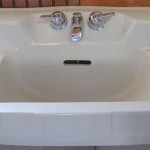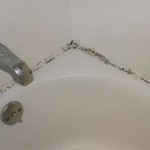Grout or Caulk Around Bathroom Sink: A Comprehensive Guide
The bathroom is a space prone to moisture and humidity, making proper sealing around fixtures essential for preventing water damage and mold growth. When it comes to sealing the area around a bathroom sink, a common question arises: should you use grout or caulk? Both materials have distinct properties and applications, making it crucial to understand the differences before embarking on your sealing project.
Understanding Grout and Caulk
Grout is a cement-based material typically used to fill in gaps between tiles. It hardens and creates a durable, moisture-resistant seal. Caulk, on the other hand, is a flexible sealant available in various formulations, including silicone, acrylic, and polyurethane. It forms a watertight barrier that can accommodate movement and expansion.
When to Use Grout
Grout is best suited for areas where there are rigid surfaces and a need for a strong, permanent bond. In a bathroom, grout is ideal for sealing the gaps between tile backsplashes and countertops, as well as for filling in the spaces between tiles around the sink. It creates a seamless, durable surface that resists moisture and mold growth.
Advantages of Grout
Grout offers several advantages for bathroom applications:
- Durability: Grout forms a hard, resilient surface that can withstand heavy use and resist cracking or chipping.
- Moisture resistance: Grout is formulated to repel moisture, effectively preventing water from seeping into the underlying surfaces.
- Mold and mildew resistance: Grout is generally resistant to mold and mildew growth, contributing to a healthier bathroom environment.
- Ease of cleaning: Grout can be cleaned with a damp cloth and mild detergent, making it relatively easy to maintain.
When to Use Caulk
Caulk is a versatile material that excels in filling gaps and sealing areas that are prone to movement or expansion. In a bathroom, caulk is ideal for sealing the edges of the sink where it meets the countertop, as well as for sealing around the faucet and drain. Its flexibility allows it to accommodate minor shifts in the sink or countertop, preventing leaks and water damage.
Advantages of Caulk
Caulk offers several advantages for sealing around the bathroom sink:
- Flexibility: Caulk stretches and conforms to movement, ensuring a tight seal even with minor shifts or expansion.
- Watertight seal: Caulk creates a watertight barrier that prevents leaks and water from penetrating behind the sink.
- Ease of application: Caulk is readily available in tubes, making it easy to apply and smooth out with a damp finger or tool.
- Variety of colors: Caulk is available in a wide range of colors, allowing you to match it to your bathroom decor.
Choosing the Right Material
The choice between grout and caulk ultimately depends on the specific application and the materials involved. For areas that require a strong, permanent bond and resistance to moisture, grout is the preferred choice. For areas that are subject to movement or expansion, caulk offers greater flexibility and a watertight seal.
It's important to note that in some cases, both grout and caulk may be necessary to create a complete and effective seal. For instance, you may use grout to fill in the gaps between tiles and caulk to seal the edges of the sink where it meets the countertop.
Tips for Using Grout and Caulk
Whether you're using grout or caulk, following these tips will ensure a successful and long-lasting seal:
- Prepare the surfaces: Clean the surfaces thoroughly to remove dirt, debris, and any existing sealant.
- Use the right tools: Choose tools that are appropriate for the material you're using, such as a grout float for grout and a caulk gun for caulk.
- Apply evenly: Apply grout or caulk evenly and smoothly, ensuring that all gaps are filled completely.
- Allow for drying: Allow grout to dry completely before applying sealant, and allow caulk to cure before using the sink.
- Maintain regularly: Clean grout regularly to prevent mold and mildew growth. Caulk may need to be reapplied periodically, especially in high-traffic areas.
By understanding the differences between grout and caulk and following the tips above, you can ensure a properly sealed bathroom sink that will protect your home from water damage and mold growth.
How To Re Caulk A Bathroom Sink Ifixit Repair Guide

Grout Vs Caulk Where Are They Used The Handyman S Daughter

Should You Use Grout Or Caulk Around A Bathtub Hometalk

What S The Difference Between Grout And Caulk Blog

Don T Caulk Here

Dealing With Nasty Grout Caulk In The Apartment Bathroom Door Sixteen

Ask A Handyman Should You Grout Or Caulk Around Tub Abc Blog

What S The Difference Between Grout And Caulk Tile Doctor

Should You Caulk Around A Bathroom Vanity Bathtubber

Here S How To Caulk Around Bathroom And Kitchen Fixtures
Related Posts







